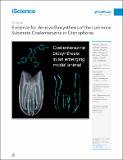Evidence for de novo Biosynthesis of the Luminous Substrate Coelenterazine in Ctenophores
Author(s)
Bessho-Uehara, Manabu; Huang, Wentao; Patry, Wyatt L; Browne, William E; Weng, Jing-Ke; Haddock, Steven HD; ... Show more Show less
DownloadPublished version (1.539Mb)
Publisher with Creative Commons License
Publisher with Creative Commons License
Creative Commons Attribution
Terms of use
Metadata
Show full item recordAbstract
© 2020 The Authors Coelenterazine is a key substrate involved in marine bioluminescence which is used for light-production by at least nine phyla. Some luminous animals, such as the hydromedusa Aequorea, lack the ability to produce coelenterazine endogenously and instead depend on dietary sources. Little is known about the source organisms or the metabolic process of coelenterazine biosynthesis. Here, we present evidence that ctenophores are both producers and suppliers of coelenterazine in marine ecosystems. Using biochemical assays and mass spectrometry analyses, we detected coelenterazine from cultured ctenophores fed with a non-luminous coelenterazine-free diet. We propose that ctenophores are an emerging model organism to study coelenterazine biosynthesis and the origins of bioluminescence.
Date issued
2020Department
Whitehead Institute for Biomedical Research; Massachusetts Institute of Technology. Department of BiologyJournal
iScience
Publisher
Elsevier BV